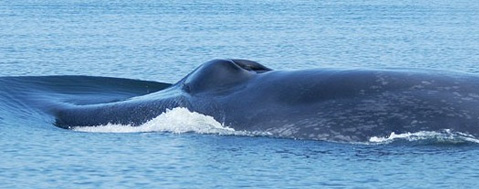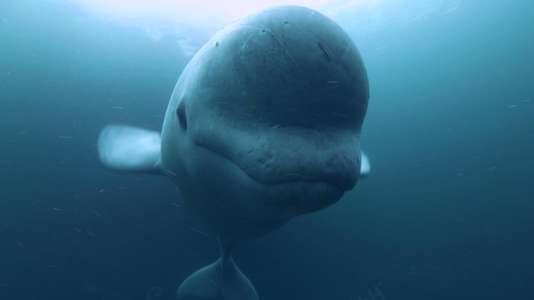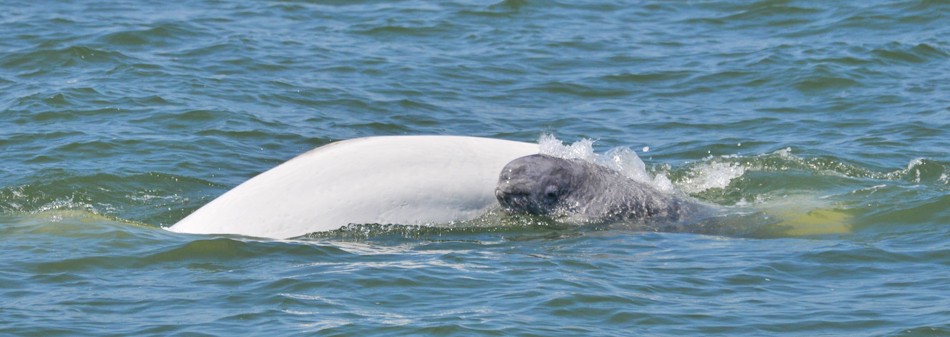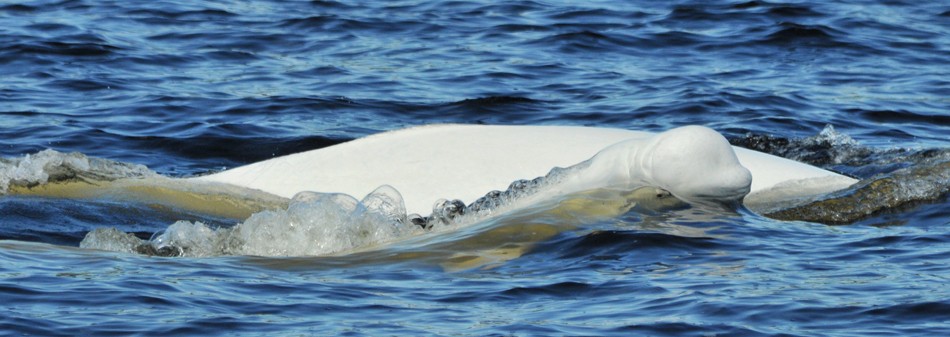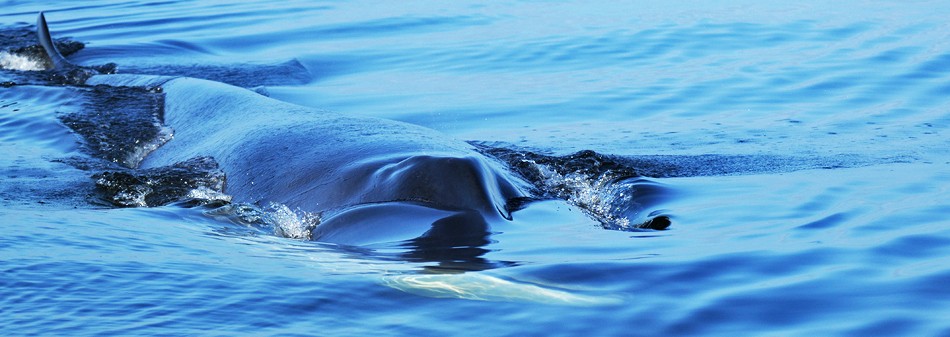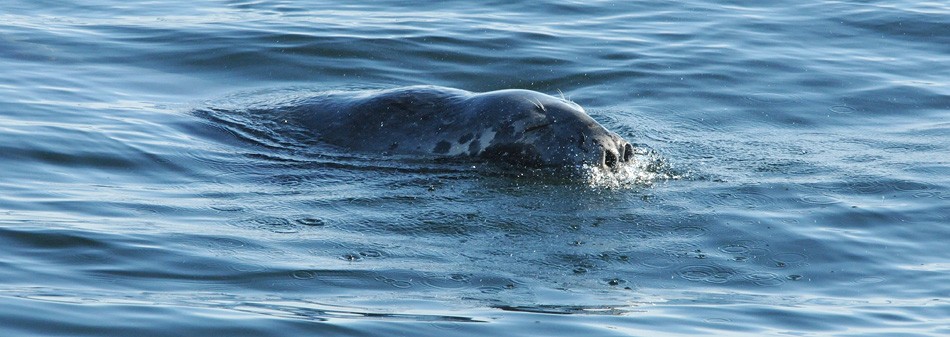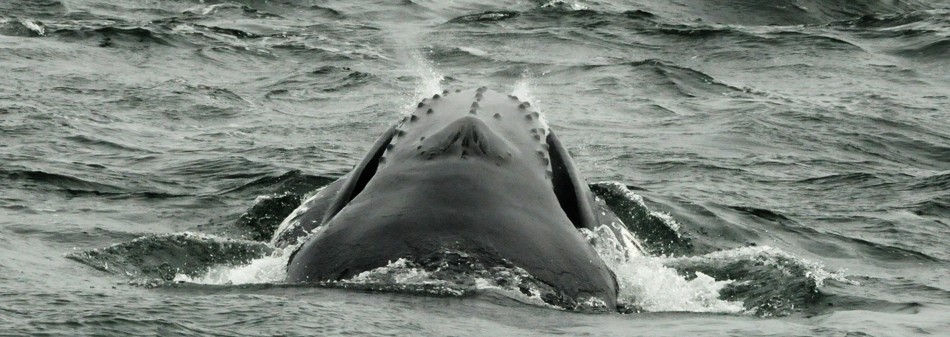19/07/2015
With the Belugas: Week of July 13
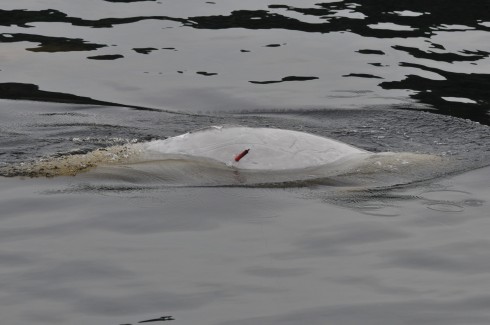
RESEARCHERS’ TIPS TO RECOGNIZE THEM
In the course of three days at sea, as part of our behavioural study project on St. Lawrence belugas, we logged 13 hours of observation. We began by exploring the mouth of the Saguenay Fjord as far upstream as Baie Sainte-Marguerite, followed by the Charlevoix sector between Cap du Basque (Baie-Sainte-Catherine) and Cap de la Tête au Chien (Saint-Siméon). On the south shore, we sailed to Île Verte, opposite Cacouna. Overall, visibility was excellent and cloud cover was low. The winds have stirred up strong waves, making navigation a bit more challenging throughout the day. Other than this day, the seas have been quite calm. We observed four herds, two of which comprised about ten adults and gray young, and the other two, larger, with a high proportion of grays and calves. Among them were two newborns that we had not even accounted for yet! Most of the time, the belugas were travelling, and were more or less dynamic.
Tuesday, July 14, 2015, 10:24 am: We are observing a calf within the herd. We can learn a number of things by observing newborns. Firstly, when a calf swims pressed against the side of another beluga, we can assume that it is the mother; and, if the alleged mother is observed repeatedly with a calf, we can conclude that it is a female. Secondly, if we know the female, we can conclude that she is fertile. By observing her year after year with her calves, we can compile a family album and understand her family ties with other belugas. In today’s observation, we have not specifically identified the calf’s mother.
Thursday, July 16, 2015: Around 10:03, we approach an adult accompanied by a young gray individual and a calf. They do not bear any specific markings, which would have made it easier for us to identify them. As adult belugas are white, the markings (scars, deformations, unique character or unusual shape) that they bear are what allow us to distinguish them. Out of an estimated population of 900 individuals, we are able to recognize about 350 using photo-identification. Within the same group, we also take biopsies of belugas that show a visible marking. As part of our study, we take this small piece of skin only from those animals that have identifiable markings. At Cap de la Tête au Chien, 150 m from the coast, we meet a group of eight whales, probably females, which appear to be moving, but are not. In fact, they are facing into the current and treading water. This behaviour is observed often in this sector. It is believed that this might be done to increase their manoeuvrability in order to capture prey.
Friday, July 17, 2015: We observe an individual showing well defined marks: a spot near its neck and a depression above. We are unable to identify it on the boat, but such distinctive characteristics make it a good candidate for a match. We always send photos of the belugas we’ve encountered to our research technicians in the lab. One of them was able to identify our beluga: it is DL0249, an individual that we last observed in 1998, 17 years ago! This beluga probably went unnoticed by us because even if the spot is always apparent, the depression above is not. Further, when we photograph belugas, it is quite difficult to capture this part of their body. A challenging photo-ID!
In short, some of the stars observed this week include Céline, Miss Frontenac, DL0030, Blanche, DL1944, Géographis, Annakpok and DL2023.
Property of the GREMM and the St. Lawrence National Institute of Ecotoxicology, the Bleuvet is a research boat dedicated to the research program on St. Lawrence belugas. Managed by GREMM scientific director Robert Michaud, the Bleuvet crew is composed of Michel Moisan, Tim Perrero and Simon Moisan.
18/07/2015
Les bières Bélugas Limitées: supporting the adopt a beluga campaign
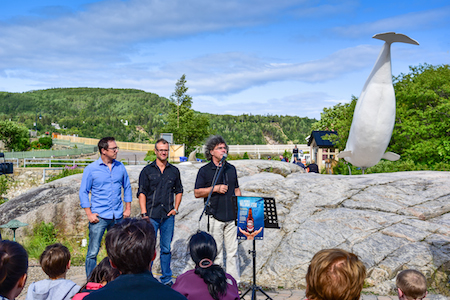
The first of a series of three beers brewed by Les Bières Bélugas Ltée has been available on the shelves of some fifty stores in Montréal and Québec City since May 27 and is now distributed by the majority of establishments in Tadoussac. This Golden Ale-type beer on lees was created to contribute to the research and conservation of St. Lawrence belugas. For every beer sold, a contribution of $0.11 will be made to the St. Lawrence Beluga Project as part of the Adopt a Beluga campaign launched last November by the Group for Research and Education on Marine Mammals (GREMM).
 This beer is the recent brainstorm of the founders of Les Bières Béluga Ltée: Patrick Cool, Frédéric Jodoin and Éric Buteau. “We were looking to create a beer at the same time as when belugas were constantly in the news. Brewers were identified throughout Quebec that had the capacity as well as the desire to develop a quality beer while contributing to an environmental cause”, says Cool. After a trip to the US to sample the market and seek inspiration, Patrick, Frédéric and Eric, in collaboration with young entrepreneurs from the Brasserie Générale de Quebec, developed a beer using American hops (Citra) that exhibits tropical fruit notes and an Australian hops (Galaxy) that presents a touch of citrus. After two weeks of in-bottle fermentation, the beer is ready to drink.
This beer is the recent brainstorm of the founders of Les Bières Béluga Ltée: Patrick Cool, Frédéric Jodoin and Éric Buteau. “We were looking to create a beer at the same time as when belugas were constantly in the news. Brewers were identified throughout Quebec that had the capacity as well as the desire to develop a quality beer while contributing to an environmental cause”, says Cool. After a trip to the US to sample the market and seek inspiration, Patrick, Frédéric and Eric, in collaboration with young entrepreneurs from the Brasserie Générale de Quebec, developed a beer using American hops (Citra) that exhibits tropical fruit notes and an Australian hops (Galaxy) that presents a touch of citrus. After two weeks of in-bottle fermentation, the beer is ready to drink.
Les Bières Béluga Ltée notably oversees an effective distribution of the product, for which demand has exceeded expectations. “It gives us great pride to see a very positive response from consumers. Beer drinkers have called for and awaited the company’s brews, and the feedback is excellent! Moreover, the cause that we care about is clearly shared by aficionados of our beer”, affirms Jodoin.
Robert Michaud, scientific director of the GREMM, is honoured to have been approached by the team of Les Bières Béluga Ltée. “It’s fascinating to see that the cause of the beluga has been such a strong rallying point. It is by ensuring the long-term sustainability of our research projects that we will succeed in creating a better future for this endangered species. The Adopt a Beluga campaign that this initiative helps support is promising for our projects”, explains Mr. Michaud.
Exponential Distribution and Contribution
The Golden Ale will be on sale throughout the summer and will give way to a Scotch Ale-type beer in early fall. This new maple beer will stand out for its amber and woody flavour. “Les Bières Bélugas Ltée will include three products that we will launch in sync with the seasons. Thus, with each new beer, we hope to raise more and more funds for the St. Lawrence Beluga Project”, says Cool, proud to see his project having become a reality.
The Adoption of “Al”
The Adopt a Beluga campaign (adoptezunbeluga.org) was launched on November 10, 2014, with the support of the Fondation de la faune du Québec, in an effort to ensure the long-term vitality of the St. Lawrence Project Beluga (projetbeluga.org), a research and monitoring program on the belugas and ecosystem of the St. Lawrence first initiated in the early 1980s. Adopting a beluga costs $5,000 and helps support research and monitoring of belugas in the St. Lawrence. Contributions from the sale of Béluga beers will go toward the adoption of “Al” and his companions.
12/07/2015
With the Belugas: Week of July 6

Our second week in the field for the beluga behavioural study was spread over three non-consecutive days (July 6, 9 and 10), for a total of 20 h at sea and 11 h of beluga observation.
The weather was rather favourable: few clouds, light winds, little rain. In short, good visibility and smooth, wave-free waters.
We first toured the upstream sectors, on the south shore of the St. Lawrence Estuary, around Île aux Pommes near Trois-Pistoles and Kamouraska. We encountered several females with juveniles as well as groups of “adolescents”, with a high percentage of “grays” and calves (newborns).
Downstream, we sailed off of Pointe Sauvage, near Les Bergeronnes. We observed groups of adults and groups of “dirty whites”, i.e. young adults, presumably males in this case. In most observations, herds were stationary but highly active. They were repeatedly diving and surfacing at the same place, a behaviour known as “milling”. Also, we had the chance to hear them vocalize and observe them spitting water. This spitting behaviour can be explained by their “sucker”-type diet. When they suck up their prey at the surface, water is spat out. The purpose of this could also be to frighten their prey. Belugas are gregarious and highly social animals. They communicate with one other with different sounds and different frequencies, some of which are perceptible to the human ear. Finally, in the course of our three forays offshore, a total of 6 herds of 15-60 belugas were observed, as were groups of gray seals and harbour seals, minke whales, porpoises and common eiders, a common sea duck in the region.
We had a guest on board this week, Antoine Simond, who is conducting a research project with Mériscope as part of his Ph.D. He collected tissue samples (biopsies) for analysis for a study of emerging contaminants (flame retardants) and their effects on minke whales and belugas.
Monday, July 6, 9:25 am:
Off of Trois-Pistoles, we made initial contact with a particularly “adolescent” herd of males and females comprising about 60 “gray” individuals. During the summer, adult males and females practise a sort of segregation. Upstream sectors are mainly frequented by groups of females, and downstream sectors by herds of males. The Saguenay area is frequented by both sexes, and mixed herds can sometimes be observed. Males form stable networks from year to year, while females form rather temporary coalitions for the season. This mixed herd of young seemed to have not yet chosen a particular sector.
Thursday, July 9, 1:00 pm: off Cacouna, we observe a female exhibiting an unusual behaviour.
We approach and find that this female is maintaining her dead calf afloat on the water surface. We had already observed this particular and mysterious behaviour in St. Lawrence belugas, but its function remains unknown. Thanks to our hydrophone, we were able to record the female’s vocalizations.
Friday, July 10: A successful day for biopsies, i.e. skin samples that enable us among other things to determine the animal’s sex and its family lineage.
This technique, performed using a crossbow, requires tremendous agility, as the shooter needs to take aim at the target in sometimes stormy sea conditions. With practice, we can achieve a success rate of 80%, but as opportunities to sample are not common, every biopsy is valuable.
In short, some of the stars observed this week include Douxi, Bonheur and DL0281.
 The Bleuvet is a boat belonging to the GREMM. It is dedicated to the long-term research program on St. Lawrence belugas.
The Bleuvet is a boat belonging to the GREMM. It is dedicated to the long-term research program on St. Lawrence belugas.
11/07/2015
With the Belugas: Week of June 29, 2015
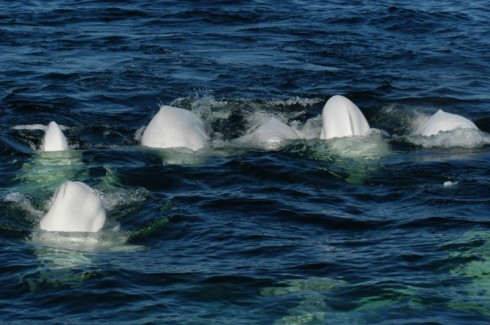
The field season for the St. Lawrence beluga behavioural study is under way. The first week consisted of three days for a total of 15 hours at sea and six hours observing belugas. Accompanied by inclement weather which lasted the entire three days (fog, wind, waves, rain), we travelled up the Saguenay Fjord from its mouth to Baie Sainte-Marguerite. When offshore conditions are compromised by heavy fog and strong winds, the weather is generally calmer in the Saguenay, which allows us to sample this sector, which is every bit as important for belugas. We therefore take advantage of this tendency to explore the Fjord. We also visited the waters south of Île Rouge, in the middle of the Estuary off Tadoussac. During the week, we observed a high percentage of “grays”, i.e. juveniles that are not yet completely white. At birth, beluga calves are light brown. In their second year they turn blue-gray (known as a “bleuvet” in French) and will fade in colour with age. The transition from gray to white occurs between 12 and 16 years. We also saw several females with young, with herd sizes ranging from 2-20 individuals. The majority of individuals were dynamic and directional in their movements; in other words, they were en route to a fixed point, without stopping along the way.
July 1, 11:00 am: We encounter an old acquaintance dating back to 1998. It is a female, Pacalou, and her “bleuvet”. In the same group, we also observe Miss Frontenac, her oldest daughter who is now about 11 years old, and who is also accompanied by her second-year young. Mother and daughter are both simultaneously “moms”. They swam up the Saguenay Fjord, from Anse à la Boule to Îles Coquarts.
July, 3:00 pm: We explore Baie Sainte-Marguerite, a restricted area where the belugas spend several hours, including a great deal of time surveying the surface and swimming in circles. We observe a group of about twenty individuals. They are highly active and are moving about quickly, making it difficult to count the number of adults and young. We take a few quick snapshots. Among them, we spot a familiar individual: Blanche, a female first identified in 2001, who is over 25 years old and who has recently been adopted by the municipality of Tadoussac.
July 3: We observe a group of about a dozen individuals south of Île Rouge that are zipping back and forth in every direction. When this type of behaviour is observed, it is almost always in this sector. Perhaps they are taking advantage of the shallow waters to feed, but on what kind of prey is anyone’s guess.
In short, some of the stars observed this week include Pacalou, Miss Frontenac, Blanche and DL1050.
 The Bleuvet is a boat belonging to the GREMM. It is dedicated to the long-term research program on St. Lawrence belugas
The Bleuvet is a boat belonging to the GREMM. It is dedicated to the long-term research program on St. Lawrence belugas
19/06/2015
Miss Frontenac is Back with her Young!
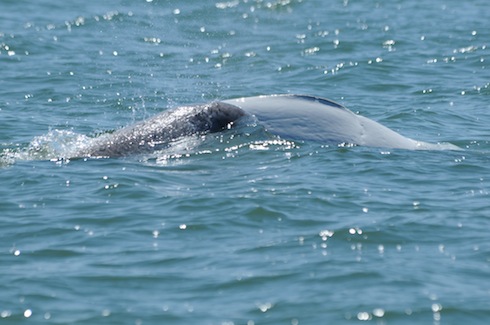
The Bleuvet crew is back on the water… and they’re off to a great start! This first day offshore held a nice surprise for us. Miss Frontenac has returned with her young.
After arriving near Île du Chafaud aux Basques, along the Batture aux Alouettes, we initiate a “contact” – this is how we refer to our tracking sessions – with a herd of females with young. The kick-off of the field season is always an exciting time. Whom will we encounter? And above all, will the female belugas who gave birth last summer be back with their year-old young? For wild animals, birth and the first year of life are the most critical times of their lives.
Miss Frontenac gave birth to her first calf in the summer of 2014 and we were eager for her to return. In fact, Miss Frontenac is a very special beluga for our team. Born in 2004, she bore a major scar on her back from the time she was just a few weeks old. She thus became the first photo-ID’d and recognizable beluga from her very first year of life. We have observed her every summer since. And it was at the age of ten that she gave birth to her first calf. We are already looking forward to seeing them again!
Miss Frontenac was adopted in 2008 by Fairmont Le Château Frontenac.
 The Bleuvet is a boat belonging to the GREMM. It is dedicated to the long-term research program on St. Lawrence belugas.
The Bleuvet is a boat belonging to the GREMM. It is dedicated to the long-term research program on St. Lawrence belugas.
15/05/2015
GREMM IS LOOKING FOR VOLUNTEER INTERNS
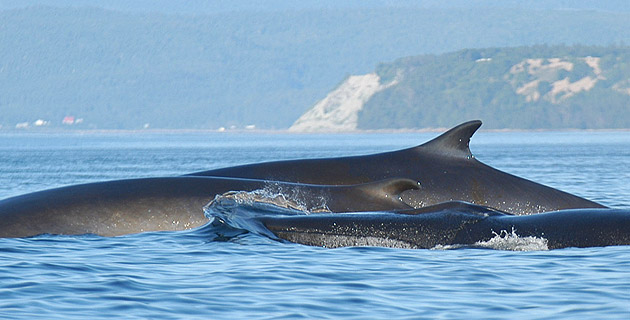
We are looking for volunteer interns for the 2015 season to participate in the photo-identification program of the great whales of the Saguenay-St. Lawrence Marine Park.
Where
- Tadoussac
Task Summary
- Photo-identification of whales onboard whale-watching vessels
- Database management (audio/Excel)
- Photo analysis work (matching)
Requirements and qualifications
- Rigor and meticulousness, analytical mindset and professionalism
- Motivation and positive attitude
- Experience in the field of photography, an asset
Modalities
- Mid-June to mid-September
- 40 h week
- Housing is provided (located a short distance from the workplace)
If interested
Please send your application by email to: [email protected]
Groupe de recherche et d’éducation sur les mammifères marins (GREMM)
108, rue de la Cale-Sèche, C. P. 223, Tadoussac (QC) G0T 2A0, Tél. 418-235-4701 Fax : 418-235-4325
20/03/2015
Autumn is a good season to observe them in the St. Lawrence Estuary
